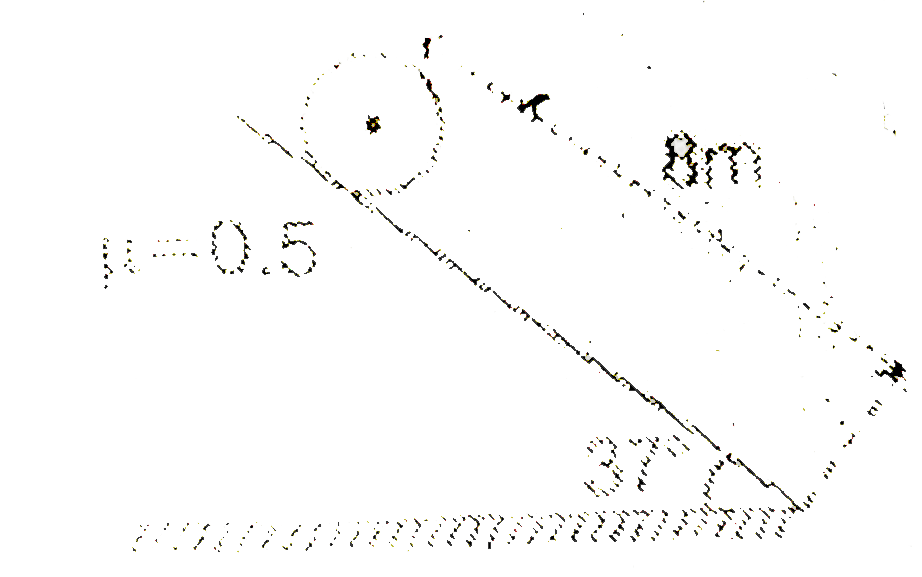A cylinder is rolling down on a inclined plane of inclination60∘. What is iths acceleration?
5 SqrtX314g
g3
g2
5g/14
The correct Answer is:A
To find the acceleration of a solid cylinder rolling down an inclined plane with an inclination of 60∘, we can use the principles of energy conservation and the equations of motion.
1. Identify the Forces Acting on the Cylinder:
The gravitational force acting on the cylinder can be resolved into two components: one perpendicular to the incline and one parallel to the incline. The parallel component causes the cylinder to roll down the incline.
Fparallel=mgsin(60∘)
2. Apply Conservation of Energy:
The total mechanical energy at the top of the incline (potential energy) will be equal to the total mechanical energy at the bottom (kinetic energy). The initial potential energy is given by:
PEinitial=mgh
The kinetic energy at the bottom consists of translational and rotational components:
KEfinal=12mv2+12Iω2
For a solid cylinder, the moment of inertia I is:
I=12mr2
And for pure rolling, we have:
ω=vr
Substituting I and ω into the kinetic energy expression gives:
KEfinal=12mv2+12(12mr2)(vr)2=12mv2+14mv2=34mv2
3. Set Up the Energy Conservation Equation:
Setting the initial potential energy equal to the final kinetic energy:
mgh=34mv2
Canceling m from both sides gives:
gh=34v2
4. Relate Height to Distance Along the Incline:
The distance s along the incline can be related to the height h using the sine of the angle:
h=ssin(60∘)
Therefore, we can express h as:
h=s⋅√32
5. Substituting for h:
Substitute h back into the energy equation:
g(s⋅√32)=34v2
Rearranging gives:
v2=4gs√36
6. Use the Kinematic Equation:
Using the kinematic equation v2=u2+2as (where u=0), we have:
v2=2as
Setting the two expressions for v2 equal gives:
2as=4gs√36
Canceling s (assuming s≠0) gives:
2a=4g√36
Simplifying yields:
a=2g√36=g√33
7. Final Result:
The acceleration of the cylinder rolling down the incline is:
a=g√3
The gravitational force acting on the cylinder can be resolved into two components: one perpendicular to the incline and one parallel to the incline. The parallel component causes the cylinder to roll down the incline.
The total mechanical energy at the top of the incline (potential energy) will be equal to the total mechanical energy at the bottom (kinetic energy). The initial potential energy is given by:
Setting the initial potential energy equal to the final kinetic energy:
The distance s along the incline can be related to the height h using the sine of the angle:
Substitute h back into the energy equation:
Using the kinematic equation v2=u2+2as (where u=0), we have:
The acceleration of the cylinder rolling down the incline is:
Topper's Solved these Questions
Similar Questions
A solid cylinder is rolling down a rough inclined plane of inclination θ. Then
View SolutionA sphere rolls down on an inclined plane of inclination θ. What is the acceleration as the sphere reaches bottom?
View SolutionA thin uniform circular ring is rolling down an inclined plane of inclination 30∘ without slipping. Its linear acceleration along the inclined plane will be
View SolutionA thin uniform circular ring is rolling down an inclined plane of inclination 30∘ without slipping. Its linear acceleration along the inclined plane will be
View SolutionA thin uniform circular ring is rolling down an inclined plane of inclination 30∘ without slipping. Its linear acceleration along the inclined plane is :
View SolutionA cylinder rolls down an inclined plane of inclination 30∘, the acceleration of cylinder is
View SolutionA sphere rolls down on an inclied plane of inclination θ. What is the acceleration as the sphere reaches bottom ?
View SolutionA disc of radius R is rolling down an inclined plane whose angle of inclination is θ Its acceleration would be
View SolutionA cylinder rolls down on an inclined plane of inclination 37∘ from rest. Coefficient of friction between plane and cylinder is 0.5. Calculate the time ( in s) of travelling down the incline 8 m as shown in figure .(g=10m/s2)

View SolutionA block slides down on inclined plane (angle of inclination 60∘ ) with an accelration g/2 Find the coefficient friction

View Solution
